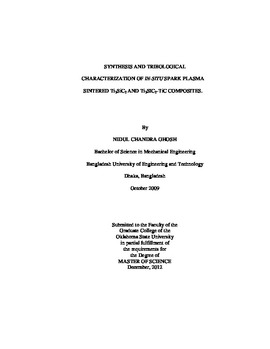| dc.contributor.advisor | Harimkar, Sandip P. | |
| dc.contributor.author | Ghosh, Nidul Chandra | |
| dc.date.accessioned | 2014-04-17T19:52:25Z | |
| dc.date.available | 2014-04-17T19:52:25Z | |
| dc.date.issued | 2012-12-01 | |
| dc.identifier.uri | https://hdl.handle.net/11244/9936 | |
| dc.description.abstract | The Mn+1AXn phases (where M is a transition metal, A is an A group (mostly IIIA and IVA) element, and, X is C and/or N and n=1 to 3) are polycrystalline nanolaminates of ternary carbides and nitrides, and exhibit unique combinational properties of metallic materials and ceramics because of their layered crystal structure. Ti3SiC2 is one of the representative members of the MAX phase family. In this research work spark plasma sintering of Ti3SiC2 and TiC reinforced Ti3SiC2 composites highlighting the effect of sintering parameters on constituting phases, microstructures and wear behavior is reported.Findings and Conclusions: In-situ synthesis of dense near-single phase Ti3SiC2 ceramics from 3Ti/SiC/C/0.15Al starting powder using spark plasma sintering (SPS) at 1250 �C (uniaxial pressure of 50 MPa and soaking time of 15 min) is reported in this research work. Systematic investigation of effect of sintering temperature, in the range of 1050-1450 �C, on the phase development and wear behavior is presented. Also, the effect of starting powder composition on phase development after SPS sintering at 1150 �C is investigated using three distinct compositions (3Ti/SiC/C, 2Ti/SiC/TiC, and Ti/Si/2TiC). The reaction mechanisms leading to formation of Ti3SiC2 and the possibility of formation of Ti3(Si1-xAlx)C2 solid solution during SPS sintering are critically analyzed. SPS has been successfully employed for in-situ processing of Ti3SiC2-TiC composites with TiC content varying from 0 to 30 vol.% using TiC/Si/Ti/Al powder mixture at 1250 �C for 15 min and with 50 MPa of pressure. Experimental phase content of TiC on the sintered composites are calculated from X-ray diffraction results and compared to the theoretical TiC vol.% present on starting powder. From the results, the phase composition of the composites could be easily tailored by mastering initial compositions. The effect of TiC content on relative density, microhardness, and phase distribution of the consolidated composites is discussed. The triboligical response of Ti3SiC2-TiC composites against Si3N4 ball have been evaluated at room temperature using pin-on-disk rotating tribometer. | |
| dc.format | application/pdf | |
| dc.language | en_US | |
| dc.publisher | Oklahoma State University | |
| dc.rights | Copyright is held by the author who has granted the Oklahoma State University Library the non-exclusive right to share this material in its institutional repository. Contact Digital Library Services at lib-dls@okstate.edu or 405-744-9161 for the permission policy on the use, reproduction or distribution of this material. | |
| dc.title | Synthesis and Tribological Characterization of In-situ Spark Plasma Sintered Ti3sic2 and Ti3sic2-tic Composites. | |
| dc.type | text | |
| dc.contributor.committeeMember | Kalkan, Kaan | |
| dc.contributor.committeeMember | Singh, Raman | |
| osu.filename | Ghosh_okstate_0664M_12424.pdf | |
| osu.college | Engineering, Architecture, and Technology | |
| osu.accesstype | Open Access | |
| dc.description.department | Mechanical & Aerospace Engineering | |
| dc.type.genre | Thesis | |
| dc.subject.keywords | ceramics | |
| dc.subject.keywords | max phase materials | |
| dc.subject.keywords | mechanical testing | |
| dc.subject.keywords | microstructure | |
| dc.subject.keywords | spark plasma sintering | |
| dc.subject.keywords | tribology | |
